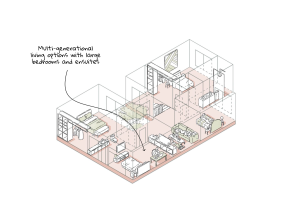Intergenerational living in Melbourne
As the pandemic persists into another year, we continue to redefine how we live and our expectations of home. Intergenerational living has become a growing trend that allows us to stay close to people we love during volatile and transformative times.
Although it may be very common in many Asian and some southern European cultures, the thought of living with our ageing parents or our adult children is… unnatural and somewhat frightening.
However, even in western cultures two-generational living has only been a trend for the last 100 years. Well now it seems multigenerational living is circling back, both for economic and cultural reasons.
Research by the University of New South Wales suggests that as many as one in five Australians live in multigenerational households, and that number is on the rise.
It’s not surprising really, as there is a strong case for living together in Australia, especially in Melbourne where affordability is an issue.
Young adults can live at home longer if they’re struggling to enter the housing market. Grandparents can help to care for their young grandchildren if both parents work. And elderly parents can stay in their own home longer with support.

Intergeneration. Photo by Ekaterina Shakharova on Unsplash.
Makes sense, right? But it’s not always about the cash-money. The isolation during the pandemic made us realise how much we enjoy being together and how critical that is for our wellbeing.
Read more about how architecture can play a part in our mental health and wellbeing.
So if multigenerational living does indeed make a comeback, what does this look like for Melbourne?
More accessible housing
Well, if the norm was ageing parents living with their children and grandchildren, architects would have to put accessibility at the forefront of design. Rather than just ticking the box and complying with the minimum legislative requirements, accessible homes will be demanded by the market and every new home will change.
There will be the standard changes such as easy access from both the street and car parking spaces in all weather and light conditions, with less stairs and more ramps. There will be wide corridors and open spaces, more sliding doors and non-slip surfaces. Bathrooms and toilets will be a challenge to be safe as well as visually pleasing.
But accessible housing will branch out from standard (and sometimes boring) as it becomes mainstream and good design will become more ‘accessible’ accessible to housing. So people who rely on these types of homes can enjoy two storey homes or sloping blocks with the use of contemporary lifts and innovative ramps and bridges – and accessible will no longer be small and unexciting units.

Family Gathering. Image by Askar Abyaev from Pexels.
More flexible living
Of course the granny flat will still be added on but more houses will consider the granny’s when being built. So they will have self contained areas with a seperate lounges and cooking spaces.
But it’s not just about the older people, homes will be more adaptable and consider how they might be extended for a new room or living area down the track. You know, for those kids who keep hanging around. Or even for the home builders who might want a smaller retreat in their old age when the kids have kids and take over the main living space.
Other than living zones, we’ll also see a lot more beds. Whether that is more main bedrooms because there will generally be more than one couple in each household or simply built in fold away beds for the kids and grandparents who come and go.

Illustration by Little Thoughts Studio for new development Kingloch Parade, Wantirna
More diverse apartment living
A lot of new housing in Melbourne is apartments, which are not currently suited to multi generation living. Because of this we have already seen people buying multiple apartments in one complex to house their parents.
So we will see more apartment buildings designed with this in mind. For example, 2-3 bedroom apartments next to 1 bedroom apartments with flexibility to combine for multigenerational buyers.
Or to another degree we might see more senior living apartments integrated within a standard apartment complex, so rather than your older parents living next door or in a semi-detached apartment they live with other older people in a specially designed area. An example of this is Trio in Box Hill, which will have four floors of senior living apartments, aimed at 50 to 75-year-olds, featuring access to specific floor managers for support and entertainment areas for mahjong, poker and other leisure activities. All with their younger family, above them on the higher floors.

Family Dinner. Image by Tima Miroshnichenko from Pexels.
Times are changing
While not entirely something that was created by the virus, it has maybe fast tracked the intergenerational living shift.
The largest generation is now downsizing, a generation that built a lot of homes that were mostly designed for young families. It’s hard to break that cultural norm, but if anything can, a housing crisis and global pandemic can.
And Melbourne will be changed for the better, the philosophy will be “one home, many uses” and while it might not be the cure-all for affordability and personal wellbeing, it will definitely make our houses and apartments more accessible, flexible and ultimately more liveable.
Cover image by Kampus Production





